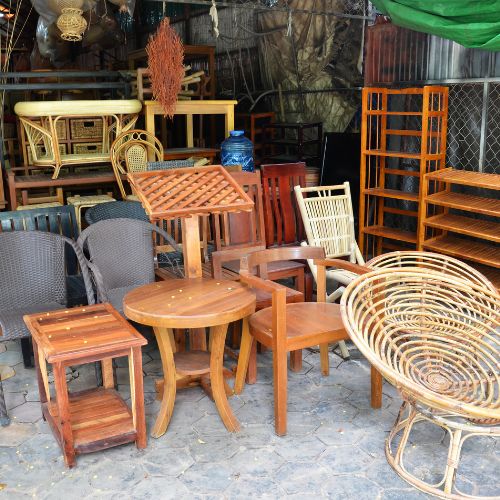
How to Upcycle Old Furniture into Stylish New Pieces: A Step-by-Step Guide
Upcycling old furniture is a creative, eco-friendly way to breathe new life into worn-out pieces and reduce waste. Whether you’re looking to refresh your home décor or save money by reusing what you already have, transforming old furniture into stylish new pieces can be a fun and rewarding process. In this guide, we’ll walk you through the steps of upcycling—from selecting the right piece to executing the transformation—so you can enjoy a beautiful, customized item that suits your space.
Why Upcycle Furniture?
Upcycling furniture offers a variety of benefits:
- Environmental Impact: By repurposing old furniture, you reduce waste and minimize the demand for new resources.
- Cost-Effective: Upcycling is typically less expensive than buying new furniture, especially if you already own the piece.
- Customization: You can tailor the furniture to match your personal style, creating a unique, one-of-a-kind piece.
- Skill Development: Upcycling can improve your DIY skills, including painting, sanding, and repairing furniture.
Step 1: Select the Right Piece
The first step in any upcycling project is choosing the right piece of furniture to transform. When selecting an item, consider the following factors:
- Sturdy Construction: Ensure the furniture is structurally sound. Look for solid wood, metal, or other durable materials that will stand the test of time.
- Potential for Transformation: Choose a piece with good “bones”—something that has a basic shape you like, even if it’s outdated or worn.
- Avoid Severe Damage: While minor scratches and scuffs can be easily fixed, pieces with major structural issues (like broken legs or deep gouges) may require more advanced skills and tools to repair.
Common Pieces to Upcycle:
- Old Dressers: Paint and replace the hardware to create a chic storage unit.
- Chairs or Benches: Reupholster the seat cushions or add a new finish to the wood.
- Coffee Tables: Sand down and stain or paint for a fresh, modern look.
Step 2: Gather Materials and Tools
Next, you’ll need to gather the necessary tools and materials for your upcycling project. These may vary depending on the piece and what you want to achieve, but here are some commonly needed items:
- Sanding Tools: Sandpaper or an electric sander to remove old finishes and smooth surfaces.
- Paint or Stain: Choose colors or stains that complement your décor.
- Brushes and Rollers: For applying paint or stain evenly.
- Wood Filler: To repair any small dents or scratches.
- New Hardware: Replacing knobs, pulls, or hinges can dramatically change the look of your piece.
- Fabric and Upholstery Tools: If you’re reupholstering, you’ll need fabric, a staple gun, and scissors.
Step 3: Prepare the Furniture
Before you start transforming the furniture, preparation is key to ensuring a smooth finish and long-lasting results. Follow these steps to prep your piece:
- Clean the Surface: Use a damp cloth to remove any dirt, dust, or grime from the furniture. If needed, use a mild soap solution for tough stains.
- Remove Old Finish: If your piece has an old finish (paint, varnish, or stain), sand it down until you reach the bare wood. This step ensures that the new finish adheres properly.
- Fill Any Imperfections: Use wood filler to repair small dents, holes, or scratches. Let the filler dry completely, then sand the surface until it’s smooth.
Step 4: Get Creative with the Transformation
Now comes the fun part—transforming your furniture into a stylish new piece! Here are some techniques to consider:
- Painting: A fresh coat of paint can completely change the look of a piece. Opt for bold colors for a statement piece or neutral tones for a more understated finish. Use multiple coats for an even look, and consider adding a sealant to protect the paint.
- Staining: If you want to maintain the natural wood look, staining is a great option. Choose a stain that enhances the wood grain, and apply it evenly with a cloth or brush. Make sure to apply a sealant after staining to protect the wood.
- Distressing: For a vintage or shabby chic look, consider distressing your furniture. Sand down the edges or lightly scuff the surface to give the piece an aged appearance.
- Reupholstering: If your project involves a chair, bench, or sofa, reupholstering can add a new layer of style. Choose fabric that complements your room’s design, and use a staple gun to attach it to the cushions.
Step 5: Add Finishing Touches
After you’ve applied paint, stain, or new fabric, it’s time to add finishing touches that will make your piece truly unique:
- Replace Hardware: Swapping out old knobs or drawer pulls for new, modern hardware can instantly elevate the piece. Look for hardware that matches the style you’re going for—sleek and minimalist for a contemporary look, or ornate and vintage for a classic feel.
- Seal the Finish: Apply a clear protective sealant to your piece to prevent wear and tear. Polyurethane, wax, or lacquer are common options that add durability and keep your furniture looking fresh.
- Personalize with Details: Consider adding stencils, decals, or even hand-painted designs to give your piece a personalized flair.
Step 6: Enjoy and Display
Once your furniture is transformed, it’s time to enjoy the fruits of your labor. Place it in your home where it will be most appreciated, whether it’s a repurposed coffee table in the living room or a newly upholstered chair in the bedroom. Upcycled pieces often become conversation starters, and you’ll take pride in knowing you created something unique and sustainable.






